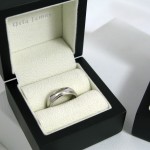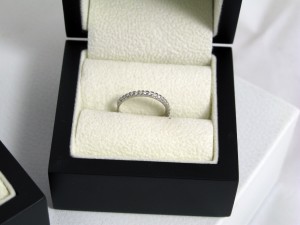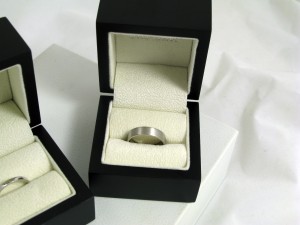So you think you might like a platinum wedding ring or engagement ring. Here’s our quick guide revealing everything you need to know to make a good decision. If you have any questions we’ll be delighted to help. Just call the team for a friendly chat.
Our buyer’s guide to platinum wedding rings & engagement rings
Platinum is cool, shiny, silvery and extremely rare, 30 times rarer than gold. It never tarnishes or fades and will retain its lovely clear glow forever.
Platinum is also remarkably dense, 40% more dense than 18 carat gold and 65% denser than palladium, giving it a reassuringly expensive-feeling weight. It’s also tougher and more hard wearing than any other precious metal.
Because it doesn’t wear away like other metals it’s a particularly safe choice, holding diamonds in their settings very securely. If you’ve ever wondered why almost every famous diamond is set in platinum, that’s the reason. You don’t want to lose something as valuable as the Kohi Noor!
About diamond and platinum wedding rings
- The diamond is usually the most precious and expensive element of a ring
- Every ring made in Britain should be properly hallmarked. If you see a ring that isn’t, walk away. You can’t be sure it really is platinum, which also brings the diamond into doubt. It could be really poor quality or not a diamond at all
-
The cut describes the way the stone’s surfaces are angled and proportioned
- The colour defines the stone’s colourlesness. The less colour, the more pure the stone and the more it costs
- The clarity of the stone describes the number of inclusions and flaws. Flawless diamonds are the most expensive. Most stones have inclusions but they’re usually too small to see with the naked eye
- The carat describes a stone’s weight and size
- Small diamond can cost more than a large one if it’s better quality, ie. colourless and free from inclusions
About British platinum hallmarks
The law says all British-made platinum jewellery must be hallmarked.
- 999 means 99.9% pure, the most expensive version of the metal
- 950 means 95% pure, the commonest grade of the metal used for jewellery, whereas gold jewellery is usually around 75% pure gold
- 900 means 90% pure
Platinum is totally hypoallergenic, perfect if your skin is sensitive.
Setting options for an engagement ring with diamonds
The setting is entirely a matter of personal taste. And there are plenty of cool options.
- A claw setting holds the stone with tiny claws which allow light to reach the sides of the stone and add extra sparkle
- An invisible setting frames the entire edge of the stone, a particularly secure choice and perfect if you tend to wear your ring all the time, even when you’re doing rough stuff like gardening or sport
- A cathedral or contour setting involves raised shoulders which help protect the stone
- A channel setting is where smaller stones are set into a groove running inside the shank, the band that goes around your finger. Because the stones are set close together with no metal in between, they’re extra-sparkly
- A tension setting is where the diamond is held securely by high pressure, between two ‘arms’ of metal, keeping it in place and letting it reflect the maximum of light for a brilliant glow
- A pave setting is where the stones are held in place with tiny balls of metal, set close together in a pattern to create a broad expanse of jewels
- A flush setting holds the diamond flush with the flank, in a small hole, making it extremely difficult to knock out and lose
You can also buy platinum wedding ring sets, where the engagement and wedding rings fit together smoothly and create a beautiful design together. They’re a great idea for comfort as well as style, since they’re made to be together… just like the two of you!
What about the band itself, AKA the shank?
- The band profile tells you about the shape of the outside of the ring. It can be round (also called d-shape or domed) or flat. A flat profile is particularly popular with men since it tends to look quite masculine
- A court style is where the inside edge of the ring is curved slightly so it fits your finger better. Round and flat profiles usually come with or without court style. It’s up to you
- The band width talks about how wide it is, usually 3mm – 6mm. Any wider and, unless you have massive hands, it gets uncomfortable and becomes impractical. The wider the band, the more fancy the ring can get since there’s more room for creativity
Polished or matt?
- A polished finish is as shiny as it’s possible to go
- A satin finish is lightly brushed, somewhere in between matt and polished
- A matt surface is created with a wire brush, smooth with a subtle shine and popular with men because of its subtle glow
You can also have platinum rings engraved, no problem at all. Because it’s so durable, your engraving should last a lifetime.
What else is platinum used for?
Platinum is in high demand by all sorts of industries including car manufacture, medicine and computing.
Amazingly, even though the metal is in such high demand, very little of it has been mined since its discovery. According to the Platinum Guild International, if you melted all the platinum ever mined and chucked it in an Olympic swimming pool, it would only cover a few inches at the bottom. When you buy a platinum and diamond engagent ring, you really are buying an incredibly rare substance.
Check out our collections
Click here to explore our collections of beautifullly made, properly hallmarked, great quality rings. They all come with generous discounts off high street prices and every pourchase is backed with lifetime service from people who love quality jewellery.



